Questions and Answers: October 2014
We get dozens of questions each month here at e-gardens. Neil chooses those that he feels will be of widest general interest to our readers. For that reason, plant IDs are rarely included, since they’re usually of concern only to the person sending the question. Neil also requires that a photo accompany each question; as you can see, our format provides spaces for them. If you’d like to send Neil your question, here is the quick link. Please remember to attach your photo, and give Neil the city where you garden, so he can better fine-tune his answer.
Question: I moved into this house in April, and this wisteria bloomed well in the spring and sporadically during the summer. However, it has grown out of control over the roof. Is there a way to keep it in bounds? A., no city given.
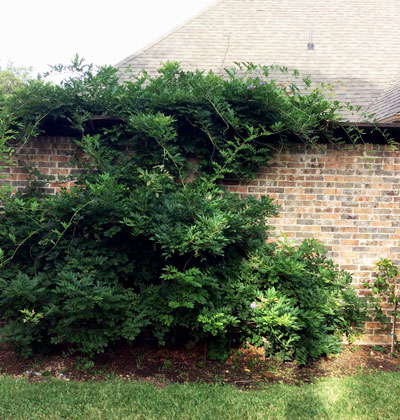
Answer: Wisterias are huge vines. One in Sierra Madre, Calif., covers several acres and they claim it to be the largest flowering plant in the world. So yours is just getting started. However, I have an alternative that might look nice for many years. You may have seen wisteria “trees,” where the plants are trained up a very stout support post and headed back time after time to keep them in tree form. You don’t see these as much as you used to, but that shows us that wisterias can withstand pruning if it’s done in spring (after bloom) and through mid-summer. You might consider having a heavy-duty trellis built out of pipe or 4 x 4 posts. You could train the plant to stay on its support. It would be almost like an espalier, only out away from the house.
Question: The bay tree in the photo, planted by the original homeowners, is very happy and very fragrant. However, it’s growing beyond anyone’s expectations. It’s overwhelming six dwarf crape myrtles planted at the same time, and the large crape myrtle behind it looks like it may get into the fray. What would you do? C.S., Streetman.
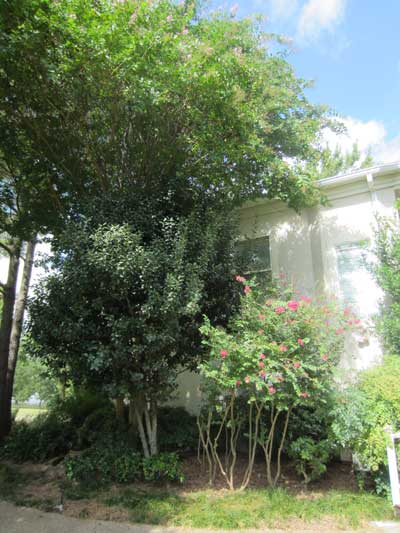
Answer: I wish I could see this from a little farther back. It looks like there might be a driveway in the foreground. If so, I wonder if the very large crape myrtle might need to be moved out of the way. I would probably relocate the miniature crape myrtles as well. Bay trees, I would think, would be marginally winter-hardy in your area, meaning that they would be fine most winters, but vulnerable with unusually cold spells.
Question: We have seen squirrels gnawing on this Japanese maple. Will it kill the tree? (Trunk has no damage.) What can we do to stop it? P.P., Plano.
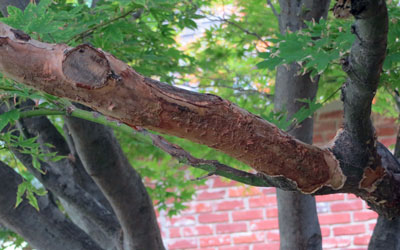
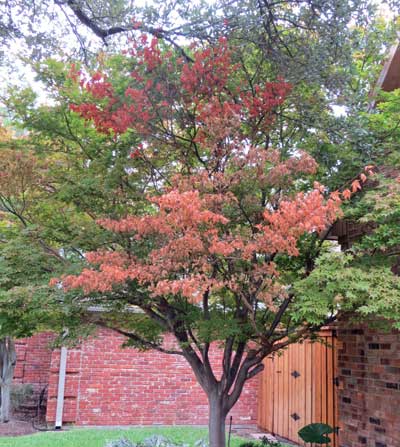
Answer: This is not good. Squirrels normally confine their gnawing and teeth-sharpening primarily to oaks and pecans. This kind of damage will definitely kill the affected branches, but it won’t kill the tree. Try whatever you can do to keep them out of this tree, even to the point of putting some kind of metal collar around its trunk (loosely) for a while. However, as long as it touches things they can climb (like the roof), they’ll jump into the tree. Better yet, you might use a gooey product called Tree Tanglefoot. Smear it on the trunk and major branches. They won’t like the feel, and they probably won’t stick around very long. That might be a good and easy first step to try. Call ahead to be sure nurseries in your neighborhood stock it.
Question: What is wrong with my camellia? E., Noonday.
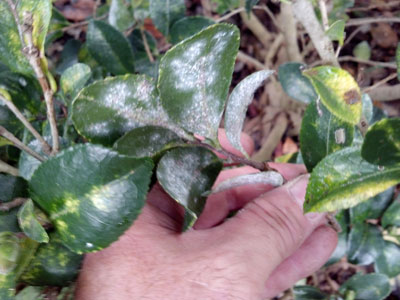
Answer: This is camellia scale, and you’ll need to stay after it with applications of systemic insecticide in spring and early summer and of horticultural oil (“dormant” oil) in the winter. The scale insects, even when killed, will remain attached to the leaves. If they’re dead, they’ll be dry and flakey. New leaves produced each spring will be free of them. Old leaves with the dead scales will be shed at that same time.
Question: I have two decent-sized bur oaks whose limbs continue to lean toward the north due to our prevailing southerly winds in the summer. Would a professional tree trimmer be able to slow down this pattern? R.H., no city given.
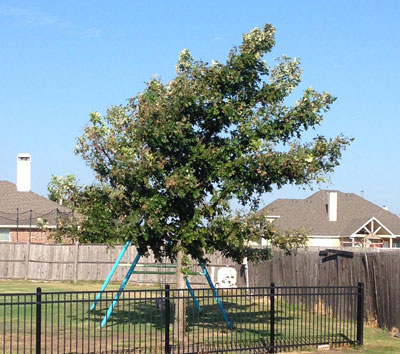
Answer: Yes. Contact a certified arborist. This should be an easy task of reshaping the top. Hopefully that pruning can redirect the future growth in a more desirable direction. I grew up in College Station, and a winged elm in our front yard had the same issue, but its trunk was even out-of-plumb.
Question: I’m thinking this is the disease TARR, but Neil’s new book says that only occurs in the spring. All of the damage is in shaded areas. Any advice would be appreciated. G.F., no city given.
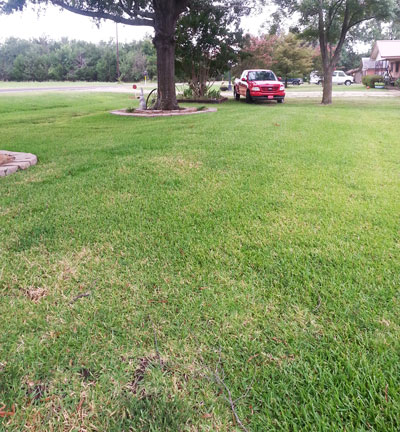
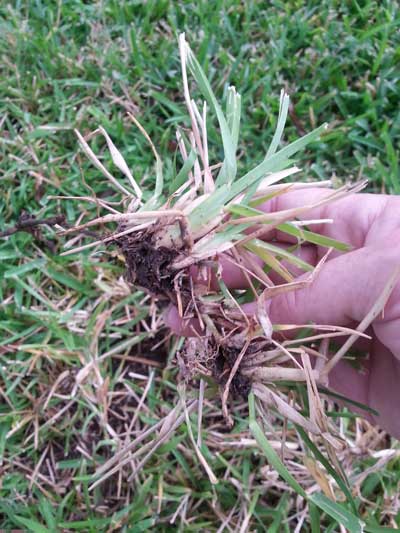
Answer: I can’t tell the cause of the trouble for sure. Your photos were taken in early September. Judging from the few roots that are visible in the tuft in your hand, I’m going to guess you have grub worms. They are active in the late summer/fall season, while TARR is a spring issue. Dig around at the edges of a couple of the patches to see if you find four or five C-shaped white grub worms per square foot. They’re likely to be a couple of inches deep by this time. If you find them, apply Imidacloptrid, and water the soil deeply. If you do not find them, I guess I’ll relent and invite you to try spreading a bale of sphagnum peat moss 1 inch deep over the areas, just to see what it might do. That’s the remedy, as you have probably heard, for TARR.
Question: I have too many potted plants to bring indoors for the winter. Would they survive the winter in this tree well if I put frost cloth over them when it might drop below freezing? S.W., Arlington.
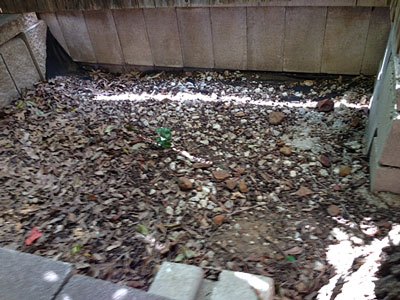
Answer: That kind of protection would probably gain you 5 or 6 degrees of protection, which might be enough for hardier types of plants. If you wanted to try leaving them outdoors with protection, you’d be better off building a hot bed. That’s similar to a cold frame, just with supplemental heating (such as cables) supplied. Without knowing the plants involved, your successes might vary. Some tropicals (bougainvillea, hibiscus, aglaonemas, dieffenbachias and others) are damaged when temperatures drop below 45. You need a greenhouse!
Question: We removed our large Natchez crape myrtles, but sprouts keep coming back. We thought we had dug them all out. What can we do to eliminate them once and for all? B. and V. G., no city given.
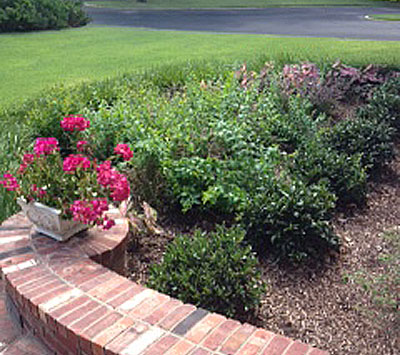
Answer: Pretty yard. I’ve had the same experience. If you still have access to the original stumps, even if they’re at ground level, drill into them with a quarter-inch bit, and carefully pour a broadleafed weedkiller at full strength. Do not allow it to run into the soil – just into the reservoirs you’ve created in the drilling. If you do not have access to the stumps, hand-digging will eliminate them in another year or so. They do eventually give up.
Question: I planted two ligustrum trees in late spring. They were in flower when I planted them. Since then, I’ve seen no new growth. Could I have watered them too much? S., Frisco.
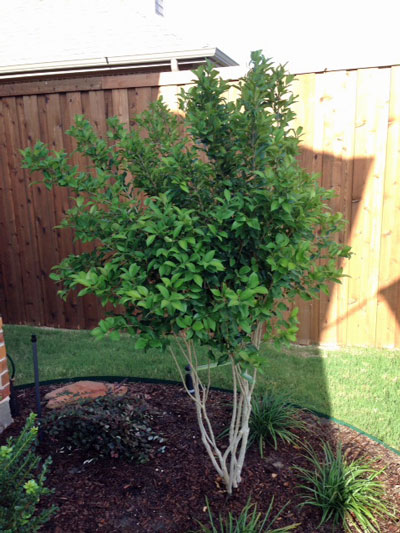
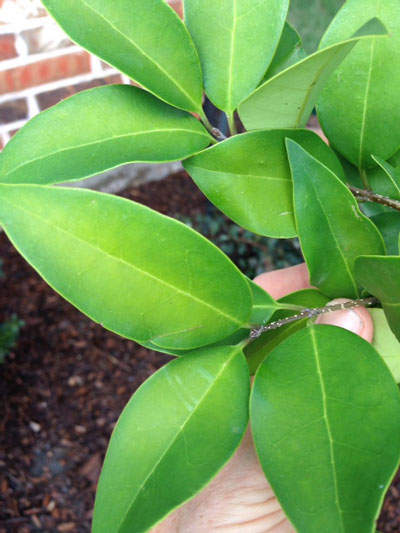
Answer: It’s extremely unlikely that you could have over-watered ligustrums in a Texas summer. It looks to me, from both of your photos, that you need to apply nitrogen. I wouldn’t add much now as we’re approaching winter, but come late March, I would make sure the plants have been fed with a high-quality lawn fertilizer that is either high-nitrogen or all-nitrogen. Just 1/4 cup split beneath the two plants, scratched in with a hoe and then watered deeply into the soil should make a big difference.
Question: This post oak has a lot of dead foliage at its top. And the post oak next to it has discolored leaves. What is happening? J.S., no city given.
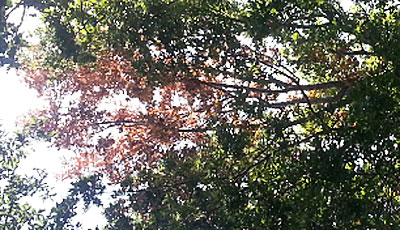
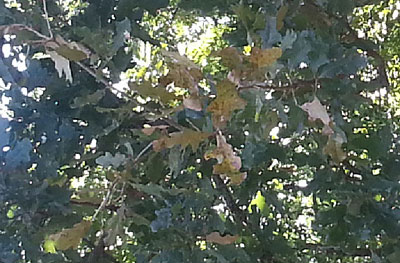
Answer: The photo showing the dead branch at the top of the tree looks like squirrel damage. (See similar situation with a Japanese maple, above.) That branch will die, and it will need to be trimmed out by a certified arborist. Lace bugs have attacked the other tree, and that tree will be fine come spring. You could apply a systemic insecticide in April next year to help discourage them from coming back next season.
Question: My grandparents had a glorious Scotch broom in California. How well will they grow in DFW? J.G., North Richland Hills.
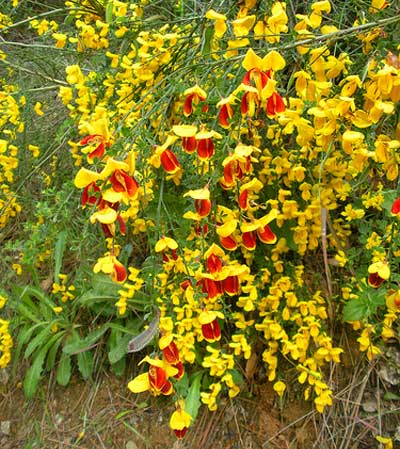
Answer: Not well. While they’re fabulous on the West Coast, they do not thrive in North Texas. Thousands are sold every spring, but think about how few established plants you see after that. That’s always my acid test for any plant that’s common in one part of America and that I might want to try in my Texas garden.
Question: What are these green beetles (look like Japanese beetles), and how can I stop them from ruining my crop of white peaches? J.B., no city given.
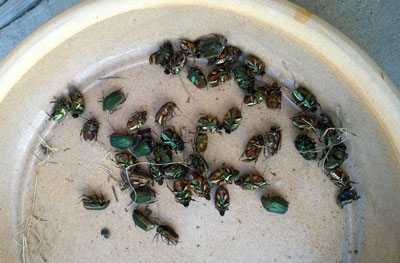
Answer: These are much larger than Japanese beetles from the North. These are green fruit beetles, also commonly called green June beetles and fig-eater beetles. As you’ll see in this fact sheet from Texas A&M, they normally feed on overly ripe fruit. The best means of avoiding them is to keep your home orchard (even if it’s only one tree) tidy and free of mummified fruit. Sprays you apply for other pests may help.
Question: Our pine tree was doing great in July, and now, two months later, it looks like it has died. The grass is doing well, so I don’t believe it has anything to do with moisture. What might have caused this? A.B.W., no city given.
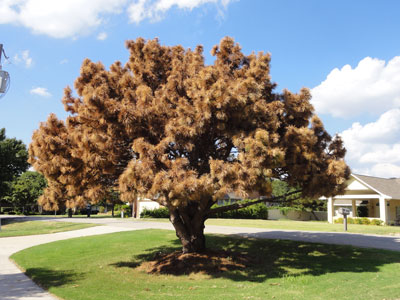
Answer: That’s really a shame. Whatever got it certainly moved quickly. I suspect a vascular disease has attacked it. We’ve seen the same thing happen to other species of pines across Texas, especially in the past 25 years. The problem usually follows a severe drought followed by ample moisture. Then, a year or so later, the trees succumb. I’ve seen it often enough in DFW that I no longer suggest pines in that area. Even 15- to 25-year-old Eldarica pines, which were touted as being perfect matches for Texas, have cratered in recent years. I would suggest you either have a certified arborist come on-site to see the tree, or at least send wood samples to the Plant Disease Diagnostic Laboratory at Texas A&M. If you don’t have other pines and don’t intend to plant any more, perhaps you wouldn’t need to worry with either of those options.
Question: We have a large cedar elm that has been yellowing for the past month. We have a lot of rock in our soil. We thought it might be iron deficiency, so we applied a couple of different products. I am worried about other cedar elms getting the same problem. Suggestions? J., Ovilla.
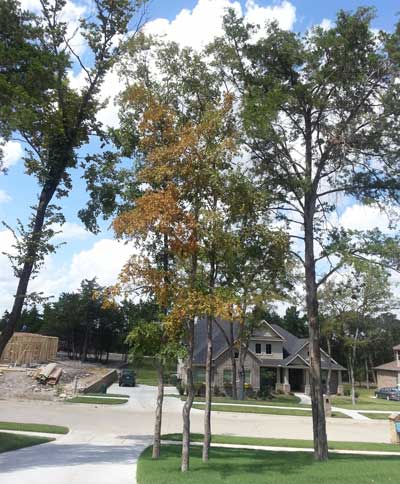
Answer: You have a beautiful neighborhood. I note that it’s also a very new neighborhood. Let me guide you through my thought processes. First, I have never seen a cedar elm show iron deficiency. Second, this is a native tree, surrounded by other cedar elms. If this were iron deficiency, you would expect to see other trees nearby showing iron deficiency, too. And then, aha! I see that this tree is only a foot or so away from the concrete. That means that it suffered a lot of root loss in the construction. I also note that all of the surviving trees look like they have been limbed up very high. That tells me that there was a lot of native undergrowth beneath the trees’ canopies. Some very major clearing was done beneath all of the trees, this one included. I would judge this to be construction damage pure and simple. I would encourage you just to sit tight and see how this tree leafs out come spring. I don’t think there is anything contagious about this problem.
Question: Where can I find this plant that I saw growing in North Richland Hills? P.W.

Answer: That’s bog spider lily, Hymenocallis liriosme. This plant loves really moist soils. You’ll find it in stores that sell water garden and koi pond supplies. Handsome plant.
Question: This fungus has shown up in several parts of our lawn. It is very hard. Fungicides don’t seem to help with it. What should I do? S.T., Fort Worth.
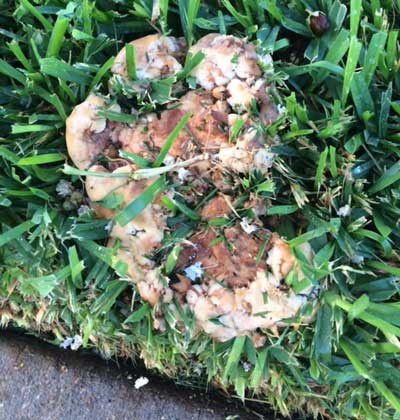
Answer: It’s saprophytic, meaning that it will do no harm to your lawn, other than to keep the sun from reaching the grass blades. It’s living off the decaying organic matter of the grass clippings. You might try dusting it with sulfur. Otherwise, wait it out!
Question: We took a few pads of Granny’s thornless cactus from Brownwood and planted them in DFW. Much of the plant is now brown, and insects are all over it as well. Would more or less water be helpful? What should we do? L. G. F., Southlake.
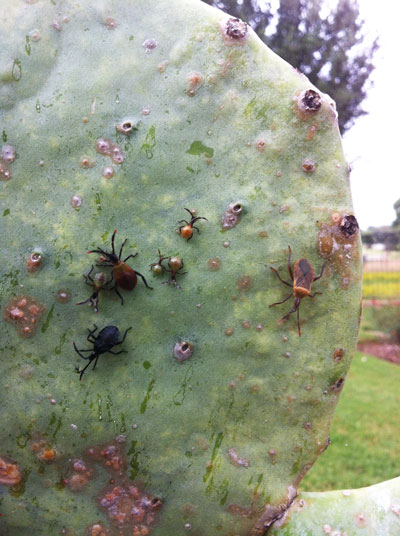
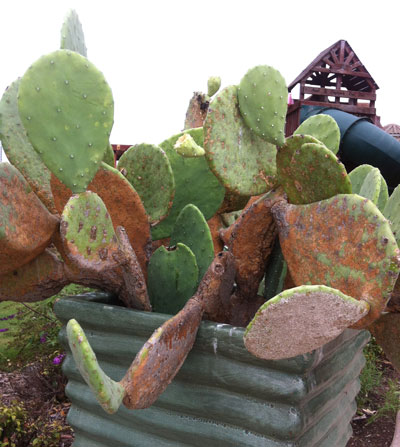
Answer: It appears to me that one of the true “bugs,” such as leaf-footed bugs, might be feeding on the succulent sides of the pads. Given time, they could do significant damage. This is not about water. You’ll want to apply a systemic insecticide in late March/early April next year.
Question: These beetles are devouring rotten apples on the ground and hanging on to my crabapple tree. Should I be trying to kill them? No name given, Burleson.
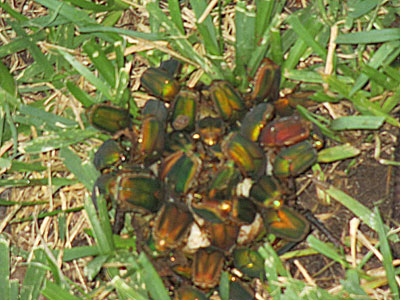
Answer: This is similar to the green June beetles in the peach question above. Keep the fruit raked up and practice year-round good hygiene of the tree. No spray is needed at this point.

